The new Host Center Kitchen floor plan reimagines their Mammoth and Yukon triple-slide truck campers. Host’s Randall Pozzi details the inspiration, design process, and what campers can expect from this bold floor plan. It’s a peninsula!
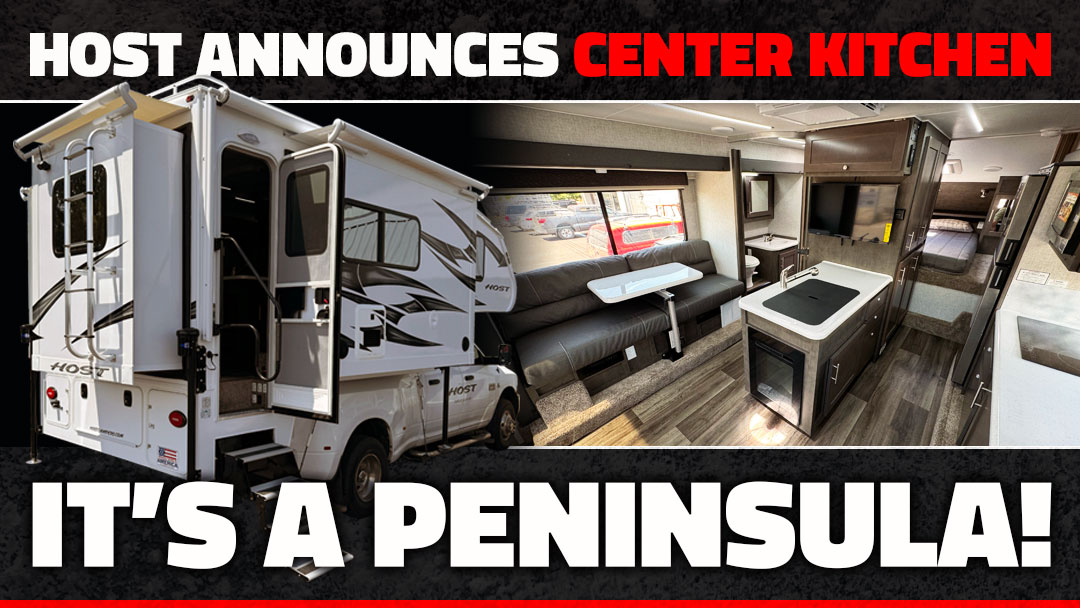
Randall Pozzi was born into a world shaped by craftsmanship and entrepreneurial spirit. His father, Arthur Pozzi, was a trailblazer in Central Oregon’s wood products industry who built one of the West Coast’s premier window manufacturing companies. Through his dedication and forward-thinking approach, Arthur created a workplace that valued quality, innovation, and a commitment to doing things the right way.
Randall absorbed those lessons and brought them into the truck camper industry, combining a relentless work ethic with a deep understanding of manufacturing and materials. During our recent visit to Host Campers in Bend, Oregon, his passion and energy were unmistakable as he worked directly with customers and supported the production team on the factory floor.
In this interview, Randall dives into Host’s latest project: the introduction of a Center Kitchen peninsula option for the Host Mammoth and Yukon triple-slide campers. The Center Kitchen places the sink in a central counter and adds extra storage, all while preserving the wide-open, above-the-rails feel Host’s triple-slides are known for.
Randall also dives into the heart of Host’s product line, sharing which floor plan combinations customers love most, and the design choices Host makes to keep their campers as light as possible. Randall then breaks down Host’s powerful Off-Grid Packages including lithium battery systems and solar upgrades.
Beyond the specs, the conversation explores matching a heavy-duty truck to a Host multi-slide camper safely. Randall explains Host’s approach to weight, options, and the kind of trucks that best support the Mammoth and Yukon models.
It’s a discussion that feels both technical and personal. Randall’s passion for helping customers, his unwavering energy, and the lessons passed down from his father come together in this interview. Whether you’re considering a Host camper or just curious about how innovation evolves in the truck camper industry, you won’t want to miss what Randall has to share.

Above: Host Mammoth Center Kitchen floor plan. The photos in this article are of the Mammoth floor plan, but the Center Kitchen is also available in the Yukon floor plan (shown below).

The Host Mammoth and the Host Yukon are hard side, triple-slide, dry bath truck campers made for long trucks. The interior floor length of the Host Mammoth and the Host Yukon is 11’6”, the width is 8’, and the interior height is 6’6”. With the slides open, the floor length is 13’6” for both units. The center of gravity from the front wall for the Mammoth and the Yukon is 58”.
The Host Mammoth and the Host Yukon have a 65 gallon fresh tank, 6 gallon water heater, 51 gallon grey tank, and 32 gallon black tank. Both models come standard with two thirty-pound vertical propane tanks.
See the article below for base and wet weight information. The Mammoth and Yukon MSRP ranges between $76,000 and $135,000, depending on selected options. The Center Kitchen option is $2,750 and adds approximately 100 pounds. Click here for more information about Host Campers.
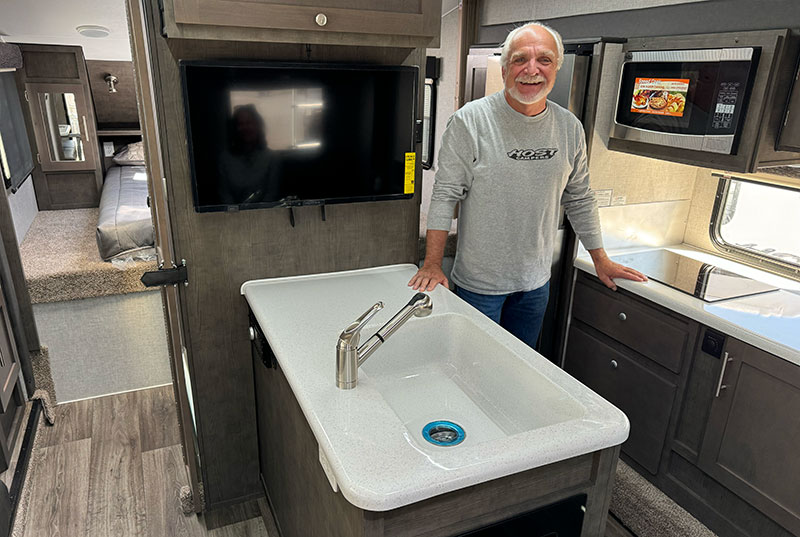
Above: Randall Pozzi, Sales Manager for Host Campers
What’s your history at Host Campers?
I started at Host in 2012 as their Sales Manager. I left in March 2022 to join Cube Series, and then returned to Host in December 2024.
The majority of my time is spent on email, phone calls, and helping Host customers and dealers. I also help the guys on the floor with new orders, participate in production and product development meetings, and work at trade shows.
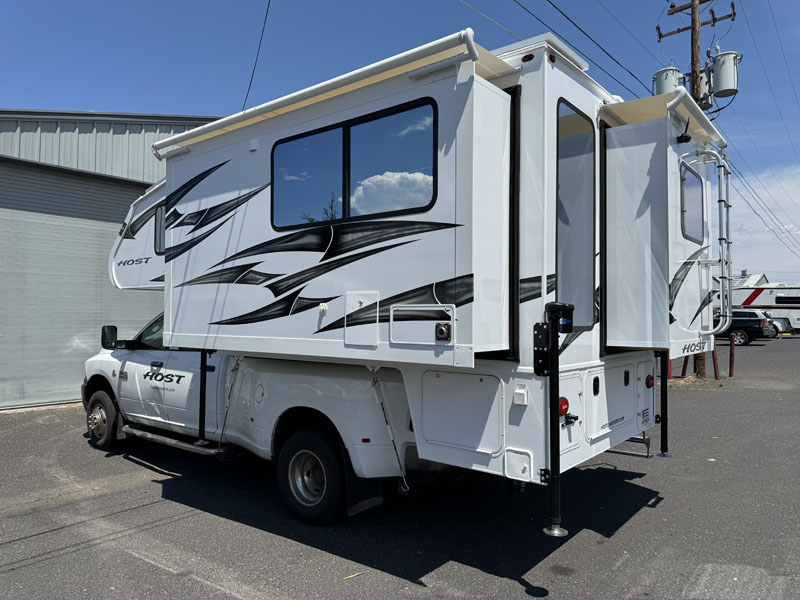
Tell us about the inspiration for the new peninsula option you’re introducing.
When we debuted our first triple-slide in 2007, we created the largest and most open floor plan ever seen in a truck camper. That was the whole idea of building above the rails and having three slide-outs.
In 2015, we designed a peninsula kitchen model. While it worked, we decided it didn’t make sense to take up the main attraction of our campers—the “wide-open floor plan”.
Ten years and numerous customer and dealer requests later, we have decided to finally debut a peninsula option in our triple-slide Mammoth and Yukon models. You lose some of the wide open floor area, but the interior is still quite open and offers access to both sides of the bedroom from the main living area and bathroom.
We debuted the new peninsula option at Overland Expo PNW in late June. We had two campers on display; one with the new peninsula, and one without. All weekend, I asked folks which they preferred. It was about a fifty-fifty split between the two.
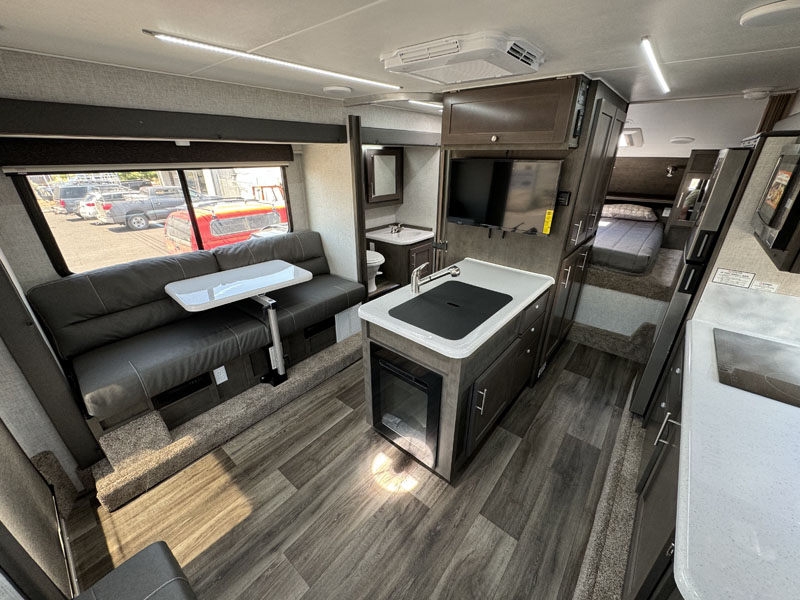
Above: Inside a Host Mammoth with the new center kitchen option
That’s interesting. What was involved in designing and prototyping the peninsula?
Host Co-Founder, Mark Storch, has been designing our campers since the company launched in 2000. Before that, he designed motorhomes at Beaver Coaches. He knows our campers inside and out, so a project like the peninsula was designed in about two hours. Building and installing the peninsula took more time, but it was a relatively quick process.
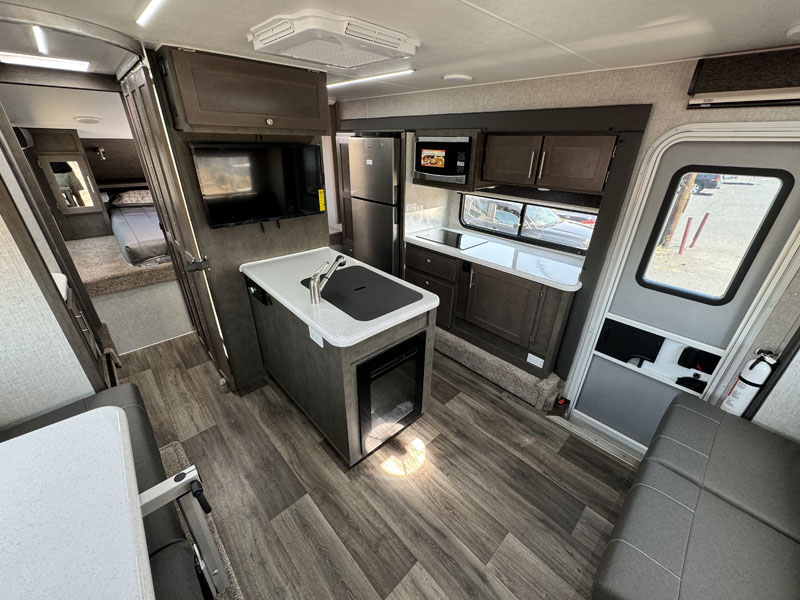
Is the peninsula effectively a new model, or an option that can be mixed and matched with other Host floor plans?
It’s an option. We are actually calling this the ‘Center Kitchen’. It’s available in our Mammoth and Yukon models.
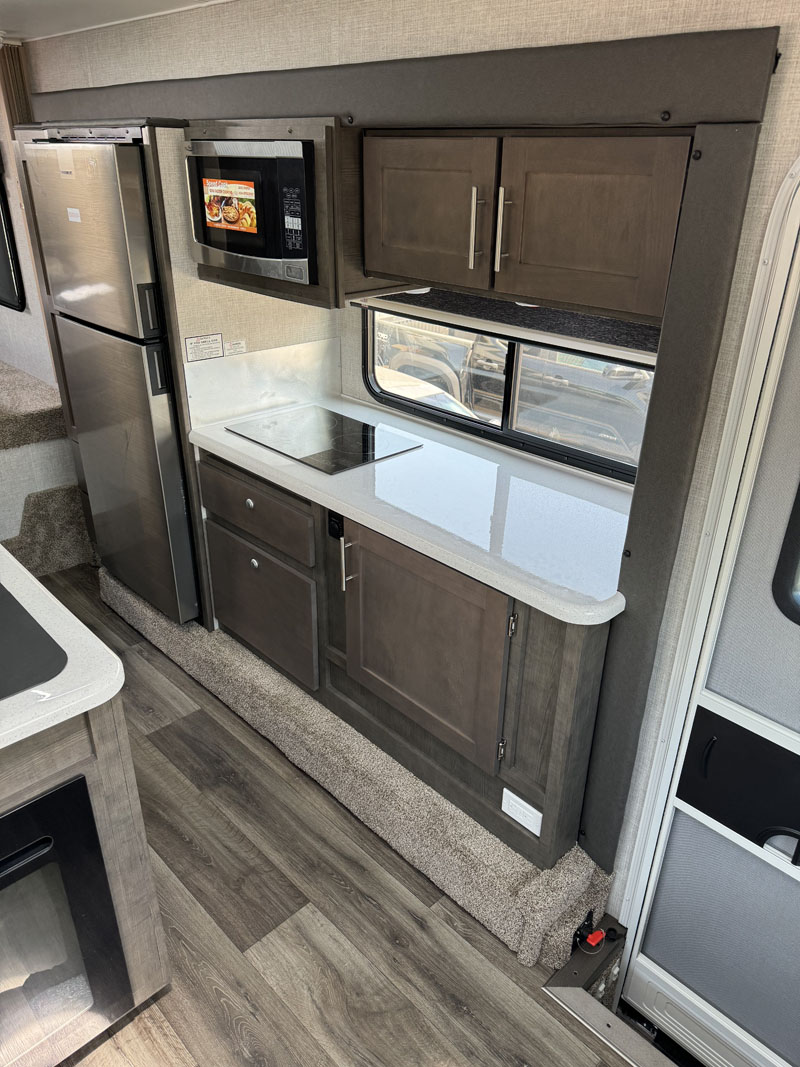
Beyond adding the peninsula, does the Center Kitchen option change the Mammoth or Yukon models?
Yes. In our standard Mammoth and Yukon floor plans, the kitchen is all on the passenger’s side slide, and the counter angles at the sink. With the new Center Kitchen option, the kitchen counter, cabinets, and slide floor all run straight, opening up more floor space.
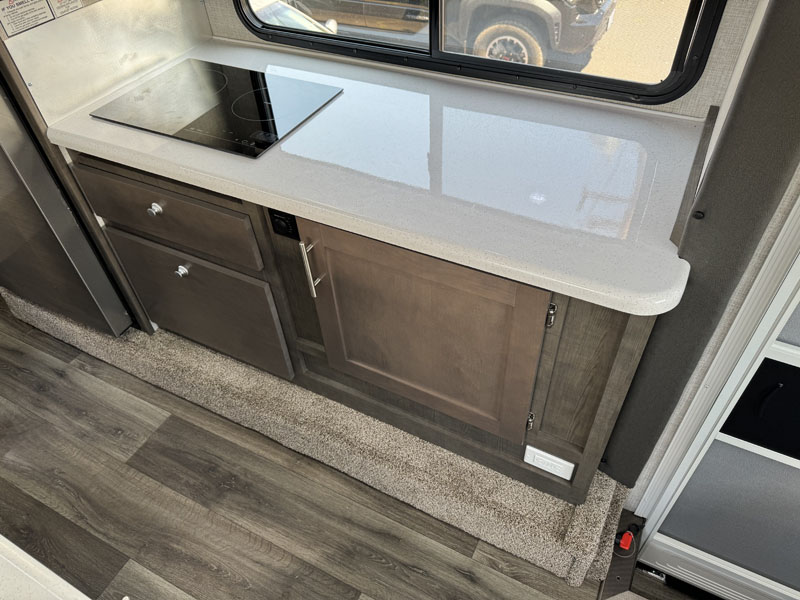
The cooktop stays in the same spot with drawers below, and the former sink area becomes storage with approximately a 3.5 foot long unobstructed counter. The sink moves to the peninsula, which also features additional cabinet storage, an additional drawer stack, and an optional simulated fireplace.
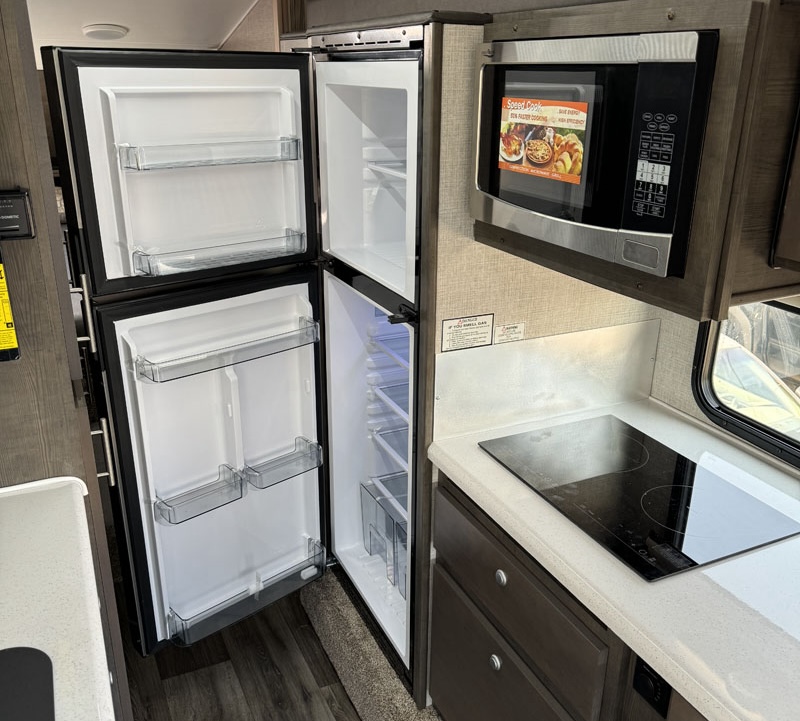
Refrigerator options are an 8 cubic foot propane/110-volt model, or an optional 10 cubic foot 12-volt model. With the 12-volt fridge option, Host requires a minimum of 400 watts of solar or one of their off-grid packages.
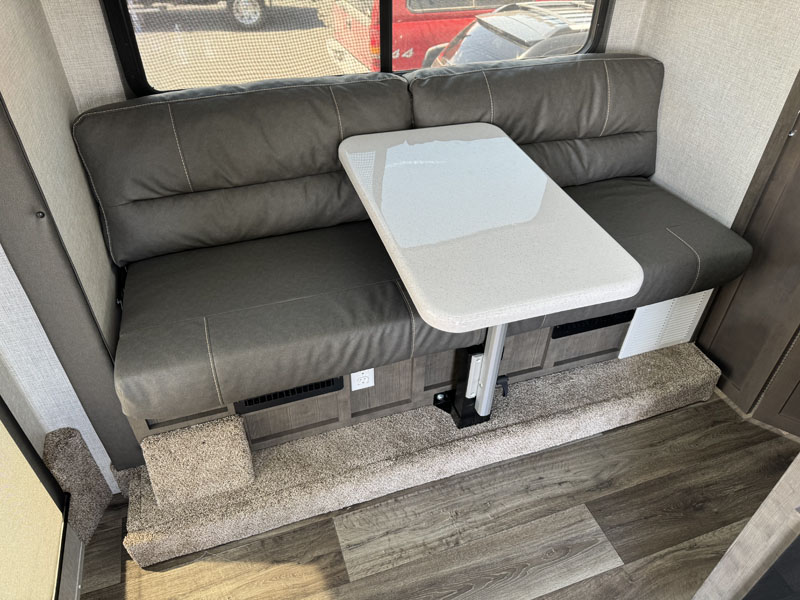
The driver’s side slide room also changes. The Mammoth gets a 6 foot couch with a removable Lagun table. With the Center Kitchen, the U-dinette or 6 foot couch with high-low table is not available.
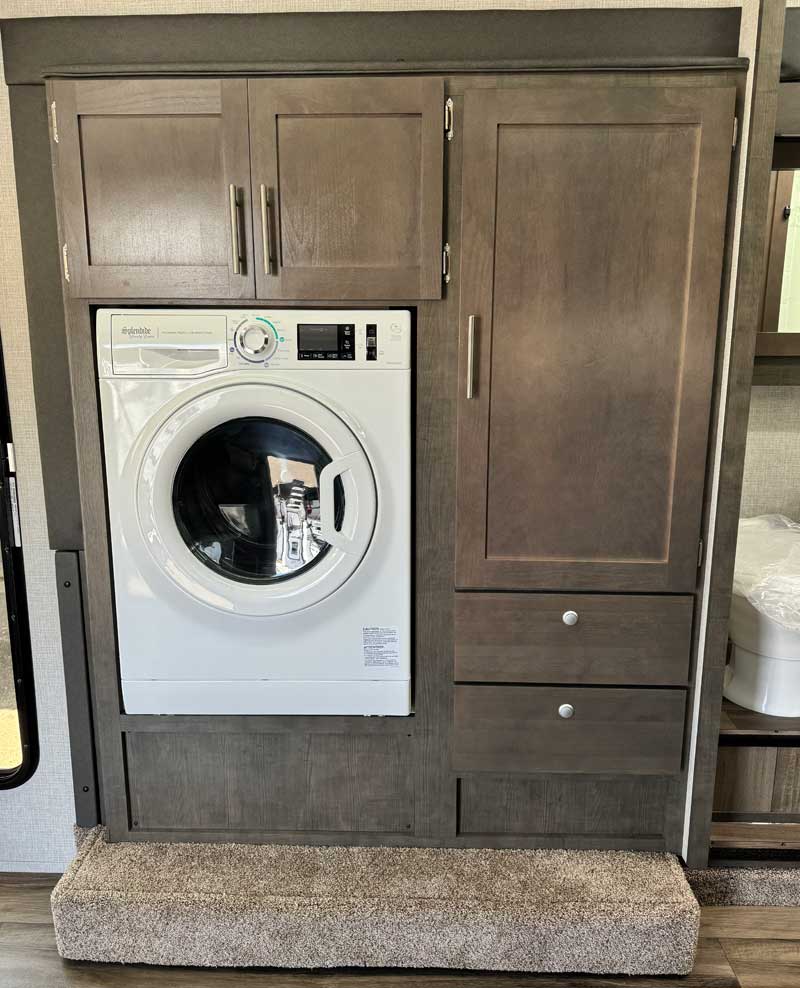
The Yukon driver’s side slide still offers a 4-foot couch, laundry center (pictured above), or full wardrobe as options.
The only other option that’s not available with the center kitchen is the outside entertainment center.
What material are Host countertops made from?
They’re 1/4 inch thick fiberglass. Our countertops and tabletops are fiberglass because it’s lighter and more durable than alternatives.
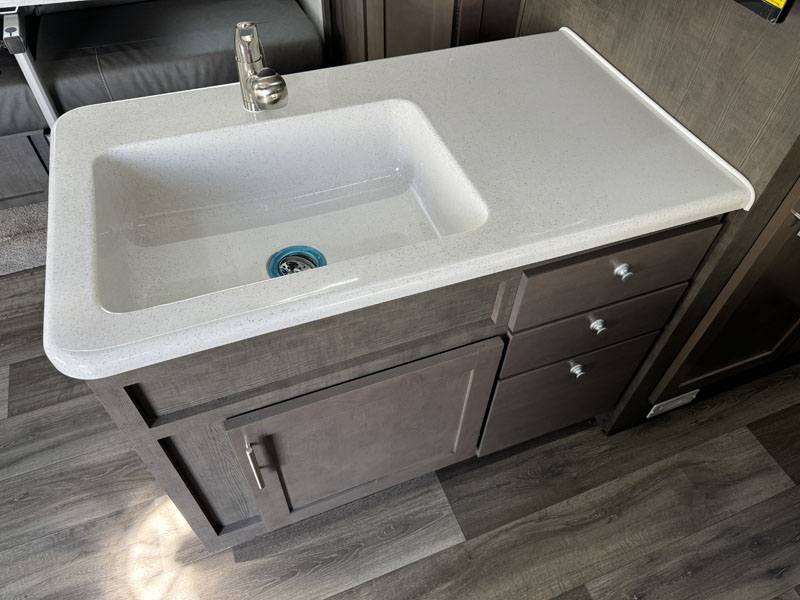
Host incorporates the kitchen sink into the fiberglass countertop. Why not use a stainless steel sink?
A drop-in sink can lead to a leak under the rim. By incorporating the sink bowl into our countertop design, we eliminate that potential. The fiberglass is also lightweight and easy to repair if it gets scratched or marked. You can simply buff it out.
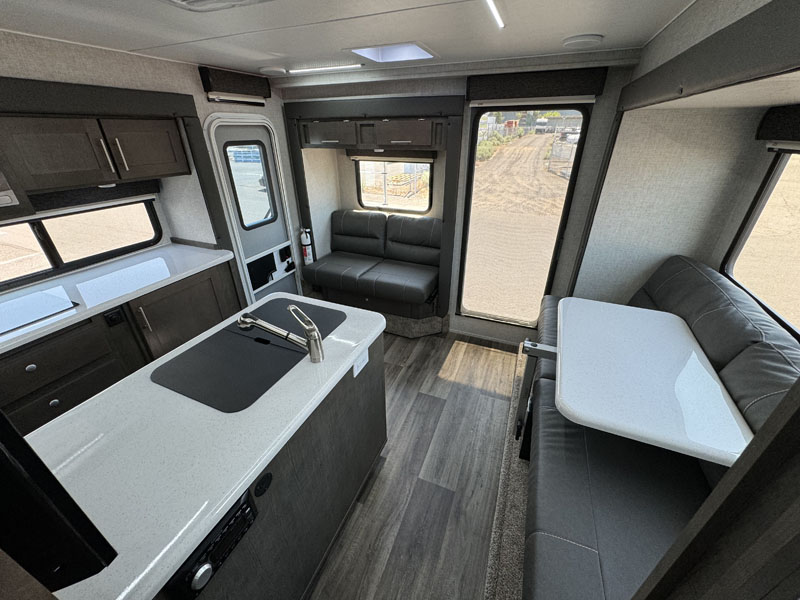
Could a Host Mammoth or Yukon owner who currently has an open floor plan come to Host to have the peninsula added to their camper?
Unfortunately, no. We had to change the slide floors to accommodate the peninsula design. We can only offer the new peninsula in a new model.
Let’s back up a bit and talk about Host’s lineup. What are the best-selling floor plan options for the Host Mammoth and Yukon?
Our original triple-slide camper was the Host Everest, introduced in 2007. The Everest and our double-slide Tahoe models represent about ten percent of our annual sales. The Mammoth, Yukon, and Cascade models represent the other ninety percent. Of those three, the Mammoth is slightly higher in sales than our Yukon or Cascade, but not by much.
The best-selling Mammoth configuration is the six-foot couch and the high-low table slide on the driver’s side, the four-foot couch on the rear slide, and the queen or king bed in the cabover.
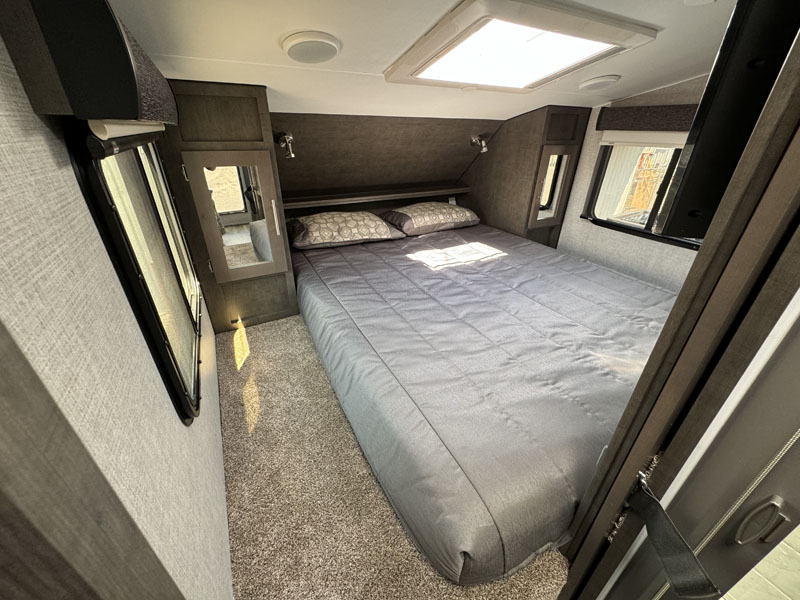
Above: Host queen bed with side cabinets. A king bed is optional
The best-selling Yukon configuration is the recliners in the rear slide and the four-foot couch slide on the driver’s side. Not far behind that combination would be the recliners in the rear slide and the full wardrobe on the driver’s slide. Again, it’s an even split between the queen and king size beds in the cabover.
In the Cascade, ninety-five percent of people get the double recliners and the L-shaped dinette.

Above: Inside the Yukon model with the center kitchen, you can get theater seating and a washer/dryer
Can you get a traditional face-to-face dinette in a Host camper?
Yes, we can do a traditional face-to-face dinette in the Yukon rear slide. The side slides in all of our models have hardware and plumbing underneath the seating or cabinetry, so a face-to-face isn’t possible.
We should talk about how Host manufactures the lightest of the hard side multi-slide truck campers.
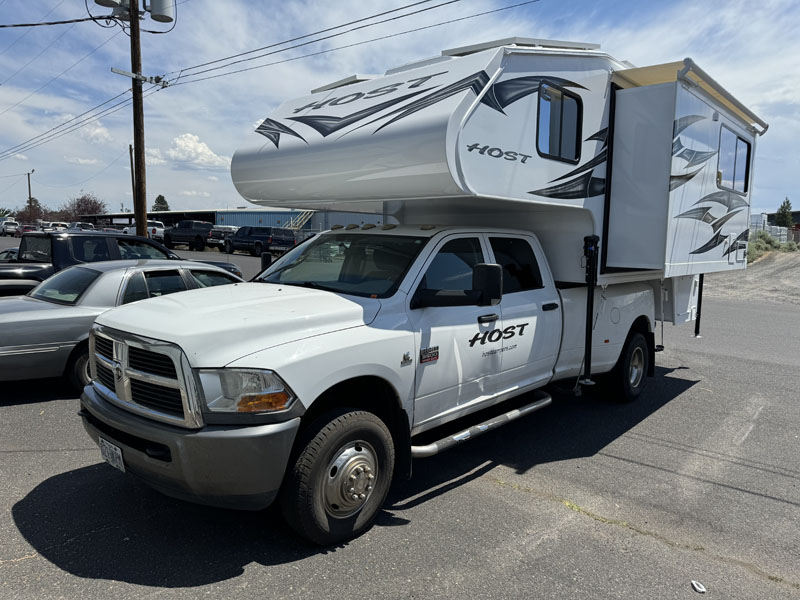
Okay. What is Host’s approach to building lightweight multi-slide campers?
We achieve that goal through careful design and paying careful attention to the weight of every material we use. A pound here and there adds up.
There’s a lot of framing in our campers, but it’s 100 percent lightweight aluminum. We use aluminum studs and rafters throughout our units. There’s no wood in the framing or structure, other than the subfloor you walk on and the marine-grade plywood under the TPO membrane on the roof.
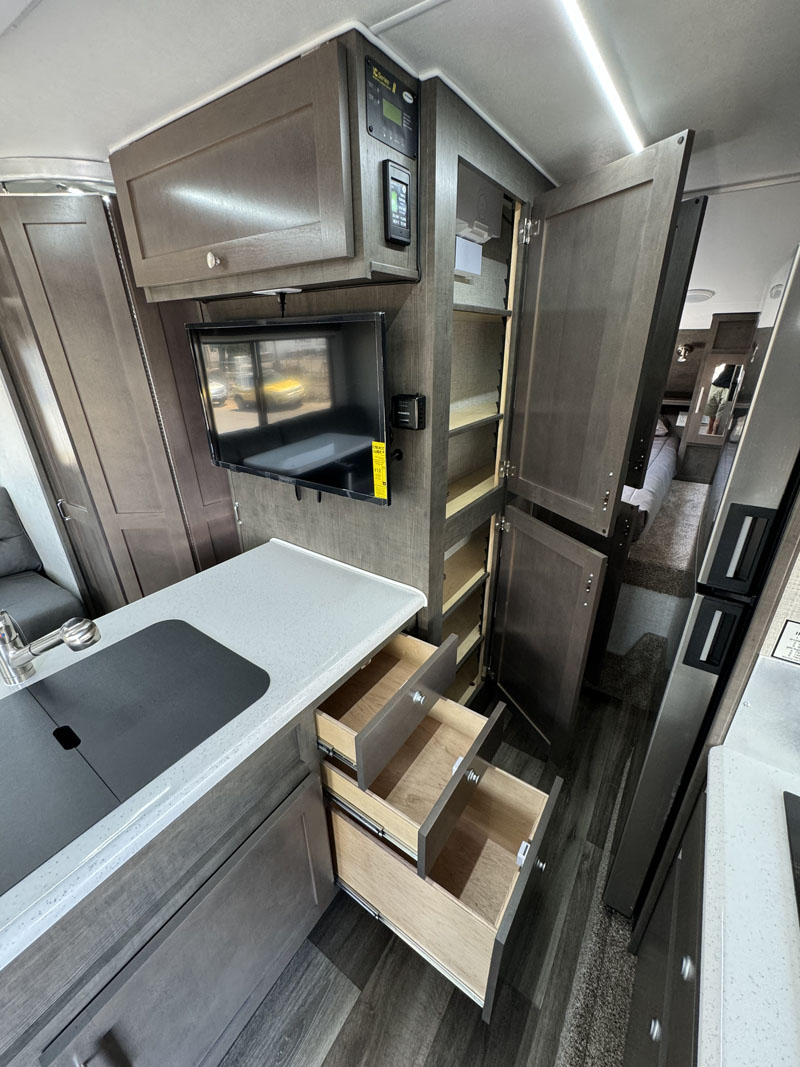
What about your cabinets?
Our cabinets utilize face-frame design. If you look at residential cabinets, they have full-thickness doors and end caps on the cabinets, which are heavy. We use a face frame made with an engineered core for a good screw bite. Then there’s 1/8 inch panel on the backside which keeps it light. If we built out cabinets like residential homes, we would add about 300 pounds. We figured out a lightweight way to do it that retains the necessary structural strength.
If you’re not using wood blocking inside your aluminum, how are you getting enough bite for screws when installing cabinetry and jacks?
Anywhere we need to attach something to the wall that doesn’t land on a stud, we laminate galvanized sheet metal inside the wall as backing.
Camper jacks experience a lot of stress and torque. To address this, we put aluminum angle iron on the inside corners of our units as well as lagging. We then through-bolt the jack mounts through the wall and the interior angle iron. This sandwiches the wall and the jack brackets. It’s an incredibly strong and rigid way to mount the jacks.
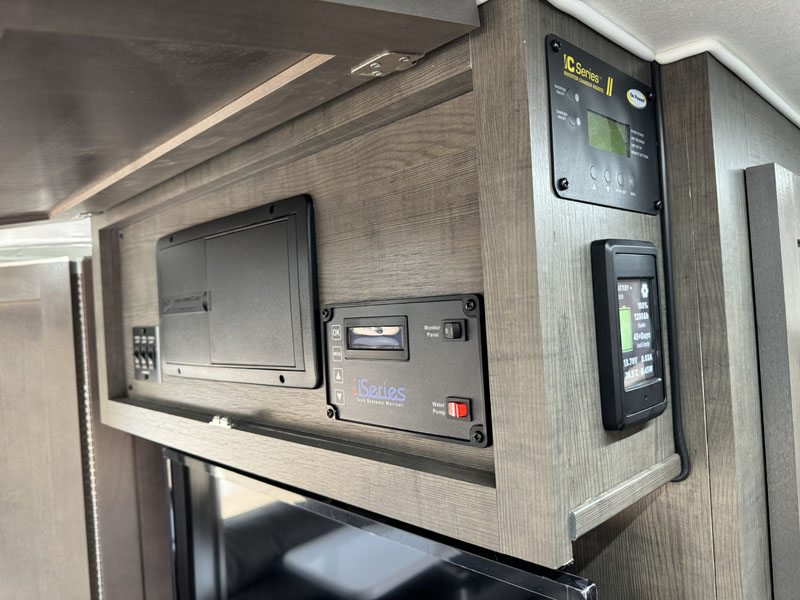
Host was an early adopter of large lithium battery systems. Tell us about your Off-Grid Package.
Host’s Off-Grid Packages are designed to keep you camping comfortably without needing shore power or a generator, thanks to lithium battery banks, solar panels, and inverters. The Off-Grid Basic package includes two 300-amp-hour batteries for a total of 600 amp hours, a 3000-watt inverter, and four 200-watt solar panels for 800 watts of solar power.
If you need more capacity, the Off-Grid Extreme package steps things up with four 300-amp-hour batteries—giving you a total of 1,200 amp hours—a 3,000-watt inverter, and four 200-watt solar panels for 800-watts of solar.
For those who really want to maximize their solar input, Host offers an option to add two more solar panels for a total of 1,200-watts, which can produce about 50 to 55 AH (amps per hour) of charging in full sun—enough to significantly offset power-hungry appliances like air conditioners.
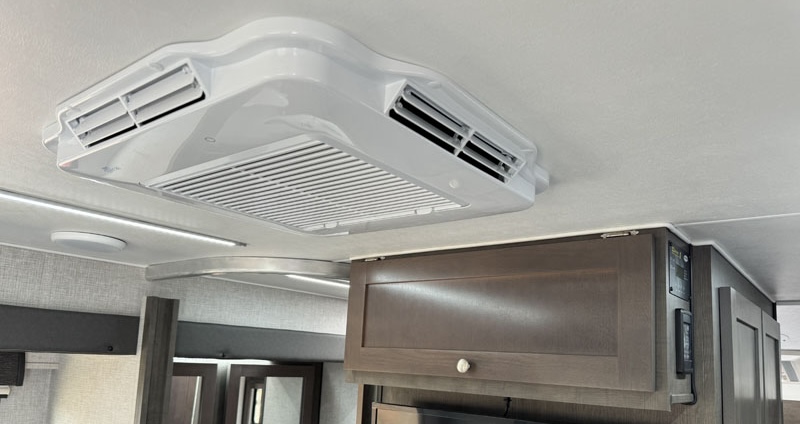
In our experience, the big lithium systems make the most sense for folks interested in off-grid air conditioning.
Yes. We use the Houghton 13,500 BTU air conditioner. The Houghton unit draws about 70 amps per hour and is relatively quiet compared to most roof-mounted AC units. When you add other loads like a 12-volt refrigerator, lights, and the inverter itself, you’re typically pulling around 80 amps total.
With the 600 amp hour systems, you can expect about six and a half hours of runtime from the batteries alone for the air conditioner. Obviously, this time frame increases substantially when you calculate solar into the mix.
If you have the optional 1200 Ah battery bank and the 1,200-watt solar setup, and it’s a sunny day, you can feed around 50 to 55 amps back into the batteries. This dramatically extends how long you can keep cool off-grid. With this large of a system, you now have the tools to really manage your power for running your air conditioner and other appliances for extremely long periods of time.
People also ask about built-in propane generators versus portable generators. Onboard generators cost about five times as much and are quite noisy inside the unit (compared to a portable unit).
A portable Honda EU2200i is much quieter and runs for hours with gasoline that you can carry with you. Propane generators consume a lot of propane. The portable is also a versatile generator that you can use for other things. For these reasons, we recommend portable generators and provide a compartment to carry one.
The math involved with the Off-Grid Packages and generator options can get a little complex, but we’re here to help.
Do you have a DC-to-DC charger option?
Yes. We just added DC-to-DC to our Off-Grid Package. It’s a 20-amp DC-to-DC. You can run it through your 7-way plug. If you want a bigger DC-to-DC, you can always add it aftermarket. That will require special wiring for both the camper and the truck.
How do you determine the dry weight of Host Campers?
When we first come out with a model, we weigh the camper, and then we weigh options. Every camper after that, we’re able to determine the weight of the camper based on the options it has installed.
Our Yukons and Mammoths range from 4,600 pounds to 5,200 pounds, depending on the options you put in them. If you have a full Off-Grid Package with lithium, solar, and a laundry center, you are going to be heavier.
The reality of it is—if you are full of water (65 gallons), propane (15 gallons), your food, gear, etc.—most of our customers are running down the road around 5,500 to 6,500 pounds.
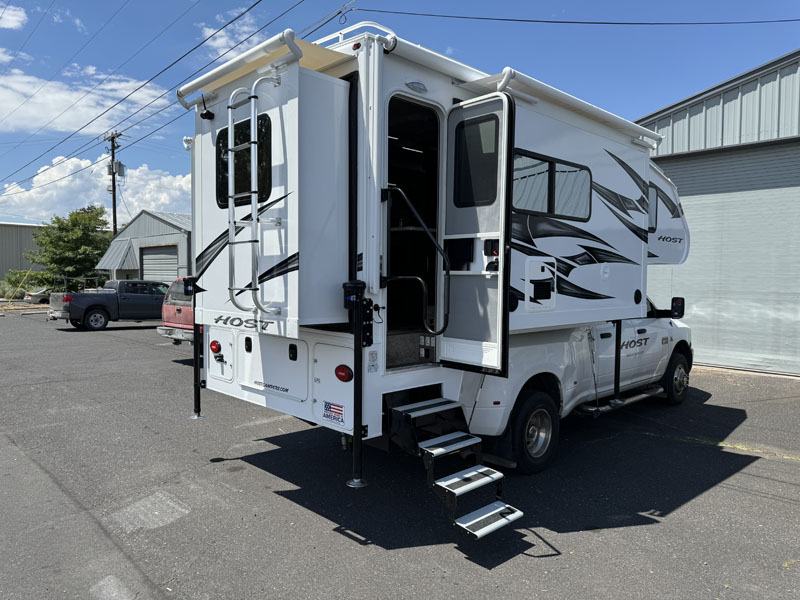
How do you approach helping customers matching Host campers to trucks?
We start by being transparent about the weight. After a customer completes our Build-Your-Own form, we send them the MSRP and the approximate dry weight of the model and configuration they’re interested in. We also give them the contact info for the Host dealer closest to them.
You can match our campers to one-ton dually trucks, but you need a one-ton dually that can accommodate the 5,500 to 6,500 pound weight previously mentioned. For example, a 2025 Ford F-350 crew cab with four-wheel drive offers up to 6,200 pounds of payload when configured with a long bed, dual rear wheels, and the 6.8L gas V8.
I highly recommend Torklift Upper Stable-Loads in combination with Timbren’s Heavy-Duty Bump Stops. If you are towing a really tongue-heavy trailer, another good setup is airbags in combination with Torklift’s upper and lower Stable Loads. For a little extra, consider adding a Hellwig sway bar. Of course, suspension enhancements won’t change the payload sticker on the truck.
If you get a Class 5 truck, you won’t need any suspension enhancements. For this reason, more and more of our customers are using F-550 and 5500 trucks. Bigger is always better, especially if you plan to tow and/or pack heavy.
Keep in mind that a Class 5 truck comes as a cab and chassis—no pickup bed—and has a longer cab-to-axle. To accommodate a Host with a Class 5 truck, you will need a flatbed with boxes.
There are tons of great options for this, including CM, Stable Camper, Bowen, Sherptek, Highway Products, and Elevation Off Grid, which extends a factory pickup bed to fit the F-550. If you’re planning a Class 5 truck and Host Camper, please call us first for fitment information. We are here to help.
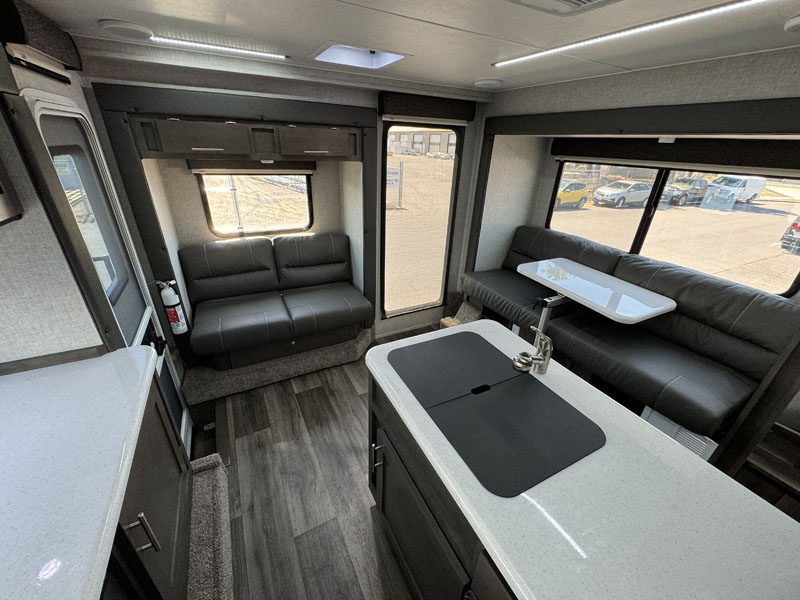
What would you want our readers to know about Host campers or the new peninsula option that we haven’t asked?
Retail customers can contact me directly with any Host questions at 541-330-2328 extension 7. Before you call, I recommend completing our Build Your Own on our website so I can better understand what you’re interested in. If you’re interested in buying a Host, I am happy to help you.
Host is different than the other multi-slide camper manufacturers. First, we manufacture the lightest of the hard side multi-slide truck campers. Second, we offer an extremely wide variety of options that create dozens of different floor plan combinations for our models. You can pick and choose what best fits your personal needs. We are not custom where you can move where the bathroom is located, but there are many floor plans within each model. There are also a variety of options to customize your camper. That’s a huge difference with Host.
I also want to invite Truck Camper Magazine readers to Bend to take a Host factory tour. I can show you the details of how we manufacture, answer any questions, and help you find the right Host for you.
For more information about Host Campers, visit their website at hostcampers.com. Click here for a free Host Camper brochure.
